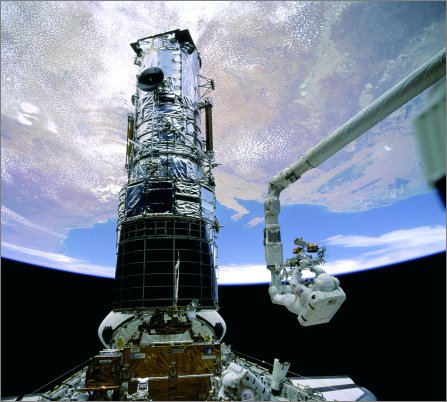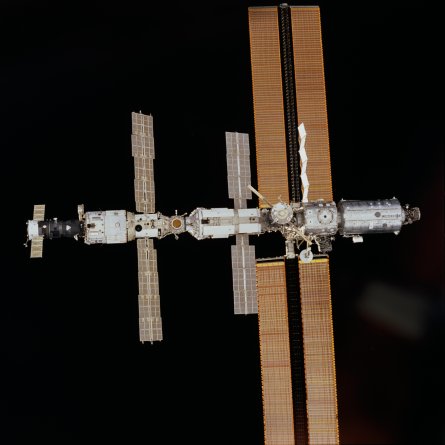Twenty-five years ago this week, the first Space Shuttle – Orbiter Vehicle (OV) 102 Columbia – blasted off the pad at Kennedy Space Center. Almost a decade after man’s final footsteps on the Moon, the test flight mission launched the USA’s latest adventure in spaceflight.
In the spirit of optimism that surrounded the 12 April 1981 first flight – Space Transportation System (STS) 1 – those exchanging handshakes, backslaps and hugs in mission control and contractor officers around the country could have little imagined that 112 successful missions later, plus two that ended in disaster, NASA would be managing the demise of the world’s only reusable spacecraft and planning a return to a capsule-style vehicle for human spaceflight.
|
| Columbia's launch on 12 April 1981 heralded a new chapter in space for the USA |
Four years ago, the Shuttle was planned to last until 2020, with programmed upgrades for the remaining four orbiters: OV-103 Discovery, OV-104 Atlantis, Columbia and OV-099 Challenger’s replacement, OV-105 Endeavour. When Columbia disintegrated on re-entry over California in February 2003, with the death of seven astronauts, the programme’s future was thrown into doubt.
Back in 1981, on that same Shuttle, the crew restarting US human spaceflight after a hiatus of five years since the 1975 Apollo-Soyuz test project were a Gemini veteran and moonwalker John Young, and astronaut candidate Robert Crippen. Young and Crippen orbited Earth 36 times during their two-day, 6h 20min flight. Its objective was to check out the overall Shuttle system, accomplish a safe ascent into orbit and to return to Earth. Columbia landed on 14 April at 17:20 GMT on runway 23 of Edwards AFB, California.
When Columbia disintegrated on re-entry over California in February 2003, with the death of seven astronauts, the programme’s future was thrown into doubt.
|
| The destruction of Columbia was a low point in Shuttle's life |
In a premonition of the problems Shuttle would suffer in later years STS-1 had been delayed from its originally scheduled flight in 1979 due to thermal protection system (TPS) tile problems.
From 1972 to 1982 Tom Moser was chief of structural design for Space Shuttle and had been technical manager for the Apollo command module structure from 1963 to 1972. He vividly remembers how tough the TPS issue was, “We advanced a lot of materials to enable the orbiter to work, with aluminum and titanium, but later on in 1978 the real challenge was the TPS. The tile was a real challenge, they do a wonderful job but they are as fragile as eggs.”
Fragile as eggs
During tests before the 1981 flight the thermal tiles were breaking. Only the application of a thin plate of cement on the bottom of each tile to enable it to spread out stresses solved the problem. Unfortunately about two-thirds of the tiles for Columbia had been installed with the old method and it took about a year to change them.
Once Columbia was rolled out to the launch pad at the beginning of 1981 the problems with the Shuttle’s external propellant tanks' (ET) insulation began, problems that would eventually destroy Columbia. After the ET was filled with the cryogenic hydrogen fuel and liquid oxygen oxidiser NASA discovered that 32 panels of tank insulation had peeled off.
The insulation was designed to keep ice from forming on the tank’s skin because the frozen moisture could break off and damage heat-shield tiles during launch. Twenty-two years later on 16 January 2003 it was a piece of insulation and ice that would damage Columbia’s TPS along its port wing during launch resulting in its failure and the vehicle’s break up during re-entry on 1 February 2003.
In 1981, days after the ultimately-doomed Orbiter had landed a post STS-1 flight inspection also revealed that ice falling from the ET had chipped and scored more than 300 of the Orbiter’s 24,300 heat-shield tiles. Hoa Vu was a McDonnell Douglas engineer and part of the stress and analysis group supporting the NASA structure team. He was troubleshooting the TPS problems before the first launch and he is amazed the shuttle is flying after 25 years. "I think we were designing it for only 15 years. After more than 100 launches I still get goose bumps watching it on television. I think pretty much every flight is a test flight and you learn something new everyday.”
Twenty five years on from 1981 and the Shuttle appears a fragile machine but in the 1970s when Space Shuttle was under development the future looked very different.
The Space Shuttle programme was announced on 5 January 1972 by then US president Richard Nixon.
The then NASA administrator James Fletcher said the Space Shuttle, would "change the nature of what man could be in space. By the end of decade the nation will have the means of getting men and equipment to and from space routinely.”
It was in 1972 that Rockwell International was awarded the contract to design and build the Orbiters.
Eventually, in 1996, Boeing bought Rockwell International’s aerospace and defense units in a deal worth $3.1 billion, and so now the aerospace giant’s Space Exploration, formerly NASA Systems, division manages the Orbiters for the US agency.
But 23 years before that, on 8 March 1979, Columbia was rolled out of Air Force plant 42 at the Palmdale, California, assembly facility.
British-born John Tribe, who had moved to the US in 1961 to work on the US space programme, had become Rockwell’s manager for the design specialists for the Orbiter’s various sub-systems at the time. “They were hectic days and since I’d been working on the shuttle since 1972 we were wondering if we’d ever get it off the ground as the months slipped by.”
When it finally did launch the 11 April 1981 edition of Flight International printed, “The lives of Commander John Young and pilot Robert Crippen, as well as the future of American spaceflight, depend on it. Space Shuttle is the first re-useable rocket and none of it has flown unmanned tests in space as happened with Mercury, Gemini and Apollo.”
Tribe shared those feelings at the time and remembers being nervous about STS-1. “After a lifetime of launches that had had some spectacular failures I was very concerned that we were launching two people on a new vehicle.”
Despite the ET insulation and tile problems and the concerns of Shuttle programme engineers Columbia successfully completed the first five flights including the first satellite deployment on mission STS-5. The sixth mission would see Challenger make its maiden flight on 30 August 1982 for STS-6. The number of shuttle flights increased from two in 1981, to three in 1982, to four in 1983, to five in 1984 and then to an all time high of nine in 1985. During that time the first satellite repair mission was carried out.
Challenger/STS-41C, launched on 6 April, saw the Solarmax satellite repaired by the Orbiter’s crew. Earlier Challenger missions, STS-7 and STS-8, both in 1983 saw the first woman and first African-American to go into space. Challenger/STS-8, which launched on 30 August 1983 carrying the Indian Space Research Organisation’s India Satellite-1A, was also the first night launch and the first night landing.
The following year a Shuttle landed at KSC’s 4,500m (15,000ft) long runway, instead of Edwards AFB or White Sands, for the first time. That was Challenger on mission STS-41G, and it landed on 13 October after an eight day mission. The following flight saw another first, the retrieval of a satellite. Space Shuttle Discovery on flight STS-51A, which launched a Canadian satellite, retrieved the Palapa B-2 and Westar-IV spacecraft. It also saw the second landing at KSC. But after all the success, tragedy struck on the second flight of 1986 with the Challenger accident on 28 January.
The subsequent investigation found that a solid rocket booster (SRB) O-ring failure had led to an SRB breach and the catastrophic explosion that destroyed Challenger. Manned flight ceased until 1988 and return to flight mission Discovery/STS-26.
|
| The deployment of Hubble Space Telescope was one of the highlights in the shuttle's career |
In 1990 Discovery would deploy the Hubble Space Telescope on STS-31 and then the first Hubble servicing mission would take place three years later on flight STS-61. Stephen Oswald, Boeing’s Space Exploration Space Shuttle vice-president and programme manager, flew on three Shuttle science missions, as Shuttle pilot for Discovery/STS-42, Discovery/STS-56 and commander for Endeavour/STS-67, a 16-day, 15h mission – a record for Shuttle.
He recalls taking control of Endeavour on 18 March 1995 for the last 2min of the return glide to land on runway 22 at Edwards Air Force Base, California, “Its exhilarating and awe inspiring. It’s such a magnificent flying machine. I flew it for 2min, from the time you go subsonic. It’s something you’ve never really done before [even with the simulations] and you’re thinking, ‘please God don’t let me screw it up’. I remember it was a scuzzy day and [the landing] was a lot more interesting than it needed to be”.
While space science and astronomy, which was STS-67’s mission, were possible uses for Shuttle when it was first proposed ultimately it was not until 1995 that it would finally begin the job it was originally designed to do, service a space station. On 27 June Space Shuttle Atlantis, lifted off from KSC to make the first Shuttle docking with Russian space station Mir for mission STS-71.
|
| Construction of the ISS has been a prime Shuttle mission |
There would be ten Mir missions in all, although the first was simply rendezvous, not a docking.
Since 1998 and Endeavour/STS-88 Shuttles have been assembling the International Space Station (ISS). STS-88 saw the US built Unity node attached to Russia’s Zarya module. However today’s ISS assembly sequence is much changed from that planned in 1998. The break up of Columbia on 1 February 2003 has altered the final configuration of the ISS because US president George Bush decided to retire the Shuttle in 2010.
But what if Columbia had not broken up, what would have happened to the Shuttle programme? Edward “Mack” Henderson is NASA’s deputy office manager in strategic planning for the Shuttle programme and he was working on Shuttle upgrades at the time, “We were planning on upgrading the main engine with advanced health management to control engine performance in-flight. We were also working on an electric auxiliary power unit to replace the hydrazine driven turbines currently used.
There was also a new fuel cell that would last twice as long at 5,000h. The cockpit upgrade was going to be very difficult and would have been ready in 2009. Now that technology is going into the Crew Exploration Vehicle,” says Henderson.
But those changes will only be what if’s in the pages of history and looking back at April 1981 Tribe, who retired in 1997 as Orbiter chief engineer, remembers that, “I was very pleasantly surprised by the wonderful performance of the orbiter on its maiden flight and vividly remember John Young literally gamboling around the nose of the vehicle after landing - he was so excited and pleased with the flight.”
In the words of NASA administrator Michael Griffin, Shuttle is “the most amazing machine humans have ever built, and it has been the recipient of the most brilliant engineering that America can provide”.
Despite two disasters and the loss of 14 astronauts the Space Shuttle remains the only reusable orbital space plane and that is a claim that is likely to remain for decades to come after the fleet’s retirement.
ROB COPPINGER / COLORADO SPRINGS
Source: Flight International




















